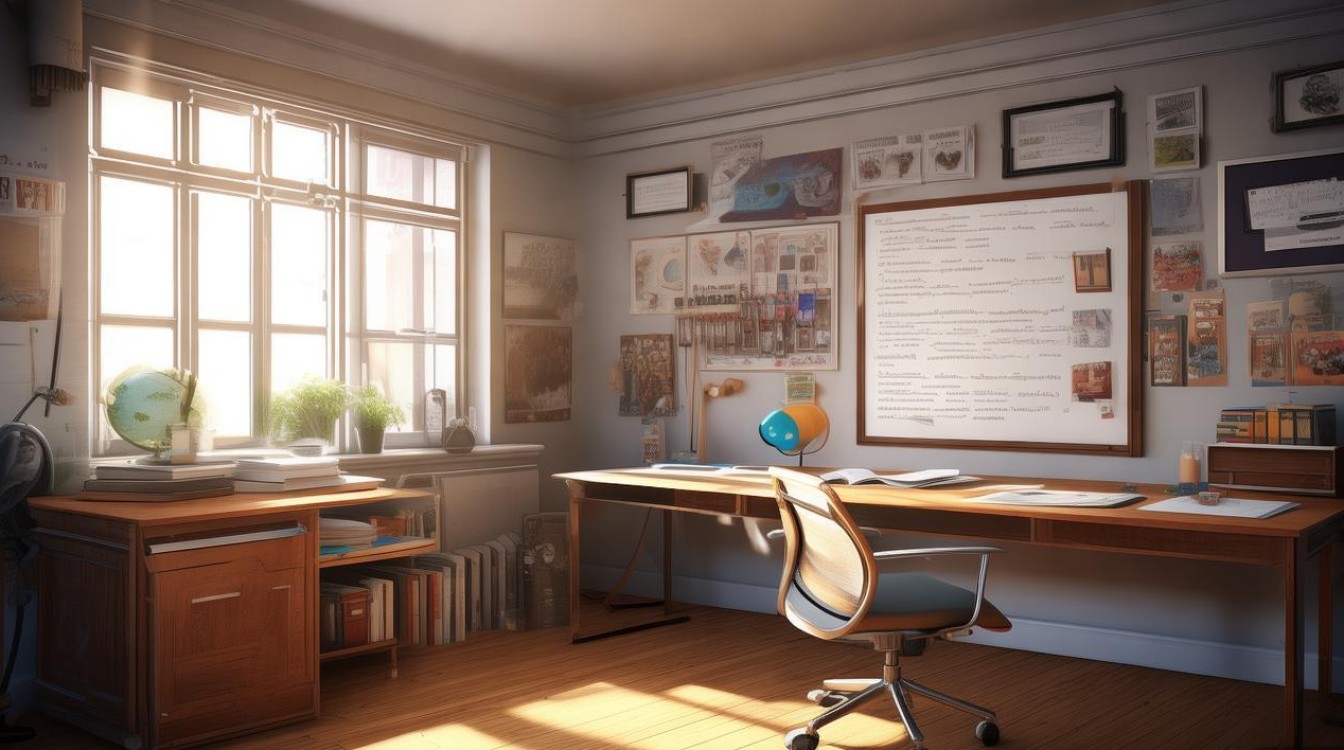雅思口语考试中,与“study room”相关的话题是高频考点,无论是描述个人空间、学习习惯,还是探讨环境对学习的影响,都可能涉及这一主题,掌握与“study room”相关的词汇、表达和逻辑框架,不仅能帮助考生在口语考试中流畅输出,还能展现对生活细节的观察力和语言组织能力,以下从多个维度解析“study room”相关话题的应考思路,并提供实用素材。

study room的核心要素:描述与细节
在口语考试中,若被要求描述“study room”,需从空间布局、物品摆放、氛围营造等角度切入,避免泛泛而谈,具体可围绕以下要素展开:
位置与大小
- 位置:是独立房间还是家中一角?“My study room is a small attic on the second floor, with a sloping roof and two windows facing the garden.”(我的书房在二楼的小阁楼,有斜屋顶和两扇面向花园的窗户。)
- 大小:用“spacious”(宽敞的)、“cozy”(舒适的)、“cramped”(狭小的)等形容词,或通过对比描述,如:“It’s not big, just big enough for a desk, a bookshelf, and a chair, but it’s my favorite place in the house.”(它不大,刚好放得下书桌、书架和椅子,但却是家里我最喜欢的地方。)
物品与功能分区
- 必备物品:书桌(desk)、书架(bookshelf)、台灯(desk lamp)、电脑(computer)、笔记本(notebook)等,可加入细节,如:“My desk has a wooden surface with a scratch from my cat’s paw, which makes it unique.”(我的书桌桌面是木制的,有一道猫爪划的痕跡,这让它很特别。)
- 功能分区:学习区(study area)、阅读角(reading corner)、储物区(storage area),“On the left side of the room, there’s a bookshelf filled with novels and textbooks, while the right corner is a cozy reading nook with a soft armchair and a floor lamp.”(房间左侧是摆满小说和教科书的书架,右侧角落则是一个舒适的阅读角,配有软垫扶手椅和落地灯。)
氛围与感官体验
- 视觉:墙面颜色(wall color,如淡蓝色“light blue”装饰画“wall paintings”)、光线(natural light“自然光”/warm lamplight“温暖的灯光”)。
- 听觉:安静(quiet)、偶尔的鸟鸣(birdsong)、白噪音(white noise,如雨声“rain sounds”)。
- 嗅觉:书香(smell of books)、香薰(scented candle)、绿植(indoor plants,如薄荷“mint”散发清香)。
study room与学习习惯:行为关联
描述“study room”时,若能结合个人学习习惯,内容会更生动、有说服力。
日常使用场景
- 学习时间:“I usually spend 2-3 hours in my study room every evening, reviewing notes and preparing for the next day’s classes.”(我通常每晚在书房学习2-3小时,复习笔记并为第二天的课程做准备。) “When I practice IELTS, I often sit at my desk to do mock tests, while I prefer reading novels in the armchair when I’m relaxing.”(练习雅思时,我常坐在书桌前做模拟题;放松时则喜欢在扶手椅上看小说。)
环境对学习效率的影响
- 正面影响:“The quiet environment of my study room helps me concentrate deeply. I can’t study well in the living room where my family watches TV.”(书房的安静环境能让我高度专注,在客厅家人看电视时我无法好好学习。)
- 优化调整:“I used to feel distracted when my desk was messy, so I started using organizers to keep stationery and books in order, which improved my efficiency a lot.”(以前书桌杂乱时我容易分心,后来用收纳盒整理文具和书籍,效率提升了很多。)
雅思口语中的高频表达与词汇
围绕“study room”积累地道表达,能提升语言的地道性和准确性,以下分类整理实用词汇:
描述环境的形容词
| 类别 | 词汇示例 |
|---|---|
| 空间 | spacious(宽敞的), cozy(舒适的), cluttered(凌乱的), minimalist(极简的) |
| 光线 | well-lit(光线充足的), dim(昏暗的), bright(明亮的), gloomy(阴暗的) |
| 氛围 | quiet(安静的), peaceful(宁静的), inspiring(有启发性的), stressful(压抑的) |
与学习相关的动词短语
- “hit the books”(开始用功学习):“I hit the books in my study room every weekend.”(我每个周末都在书房认真学习。)
- “burn the midnight oil”(熬夜):“I sometimes burn the midnight oil in my study room before exams.”(考试前我常在书房熬夜。)
- “tidy up”(整理):“I spend 10 minutes tidying up my study room every day to keep it clean.”(我每天花10分钟整理书房,保持整洁。)
细节描述高级词汇
- “knick-knack”(小摆件):“There are several cute knick-knacks on my desk, like a miniature globe and a photo frame.”(我的书桌上有几个可爱的小摆件,比如迷你地球仪和相框。)
- “ergonomic chair”(人体工学椅):“I invested in an ergonomic chair to avoid back pain during long study sessions.”(我买了一把人体工学椅,避免长时间学习时背痛。)
口语Part 2&3应试思路
Part 2:Describe a study room you use
答题框架:
- 基本介绍:位置、大小、归属(个人/共享)。
- 内部布局:主要物品、功能分区、特色设计。
- 使用场景:何时使用、学习内容、与他人的互动(如是否和家人共用)。
- 个人感受:喜欢/不喜欢的部分、对学习的影响、未来改进想法。
示例回答(精简版):
“I’d like to talk about my study room, which is a 10-square-meter space next to my bedroom. It’s not big, but I’ve tried to make it functional and cozy. The most important part is the desk near the window—its wooden surface is smooth, and I always keep a lamp, a laptop, and a stack of IELTS materials there. On the opposite wall, there’s a tall bookshelf with my favorite novels and reference books. Above the desk, I stuck a motivational quote: ‘Practice makes perfect.’
I use this room almost every day, especially in the morning when my mind is fresh. I usually practice speaking or review vocabulary here. What I love most is the natural light—it makes the room feel bright and energetic. However, the room gets a bit stuffy in summer, so I’m planning to add a small air purifier. Overall, it’s my little sanctuary where I can focus and grow.”
Part 3:延伸问题
Q1: Do you think study room design affects study efficiency?
A1: Absolutely. A well-designed study room minimizes distractions and creates a conducive environment. For example, a quiet space with good lighting reduces eye strain, while an organized desk helps students find materials quickly, saving time. On the contrary, a cluttered or noisy room can make it hard to concentrate, lowering efficiency.
Q2: What’s the difference between studying in a study room and studying in other places like a library?
A2: The main difference is convenience and personalization. In a study room, you can customize the environment—adjust the temperature, play background music, or keep your preferred snacks nearby, which makes long study sessions more comfortable. Libraries, however, offer a stricter, focused atmosphere with fewer distractions, but they may have limited space and fixed hours.
FAQs
Q1: 如何在雅思口语中生动描述study room的细节?
A1: 可以通过“五感法”增加细节:视觉(颜色、物品摆放)、听觉(安静或背景音)、嗅觉(书香、香薰)、触觉(桌面的质感、椅子的舒适度)、味觉(偶尔放一杯咖啡在书桌上)。“My desk has a smooth wooden surface that feels cool to the touch, and I always place a cup of warm coffee in the corner, releasing a rich aroma as I study.”
Q2: 如果没有独立的study room,如何描述自己的学习空间?
A2: 可以突出“功能性”和“个性化”,例如描述书房一角:“I don’t have a separate study room, but I’ve turned a corner of my bedroom into a study nook. It has a small foldable desk, a wall-mounted shelf, and a comfortable cushioned chair. I decorated it with fairy lights and a potted succulent, making it feel like my own little study zone despite the limited space.”











